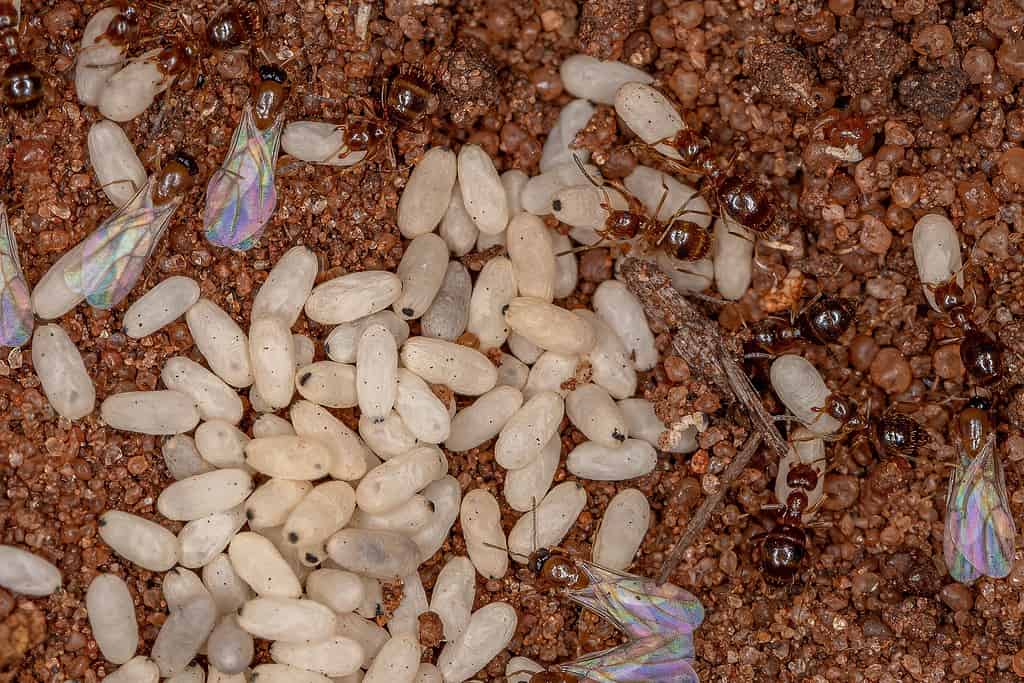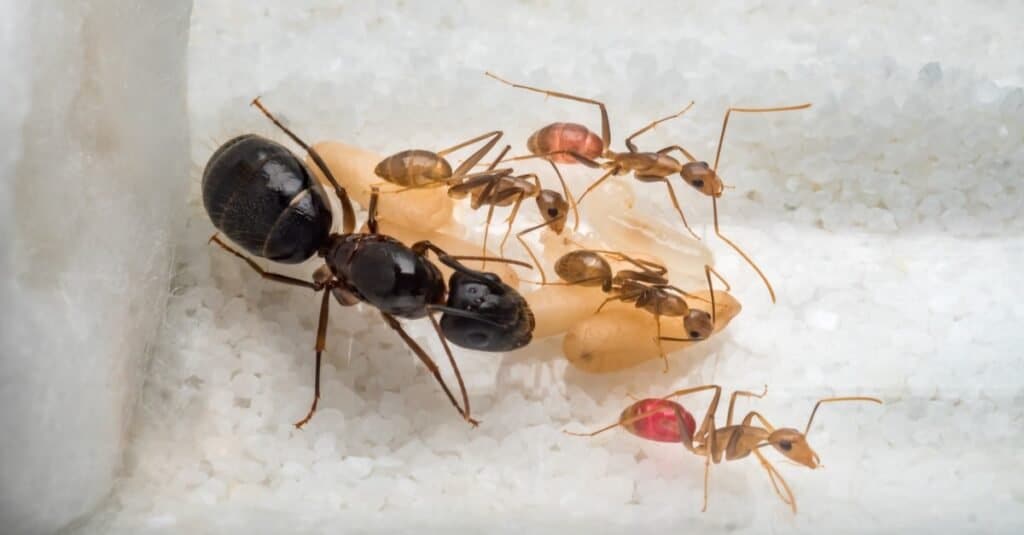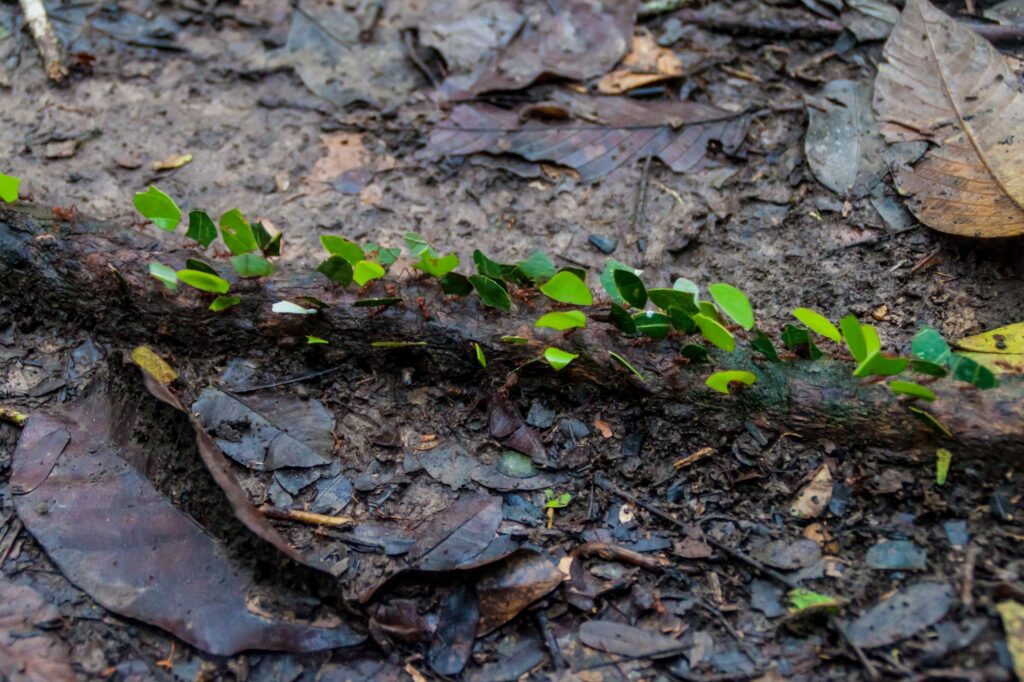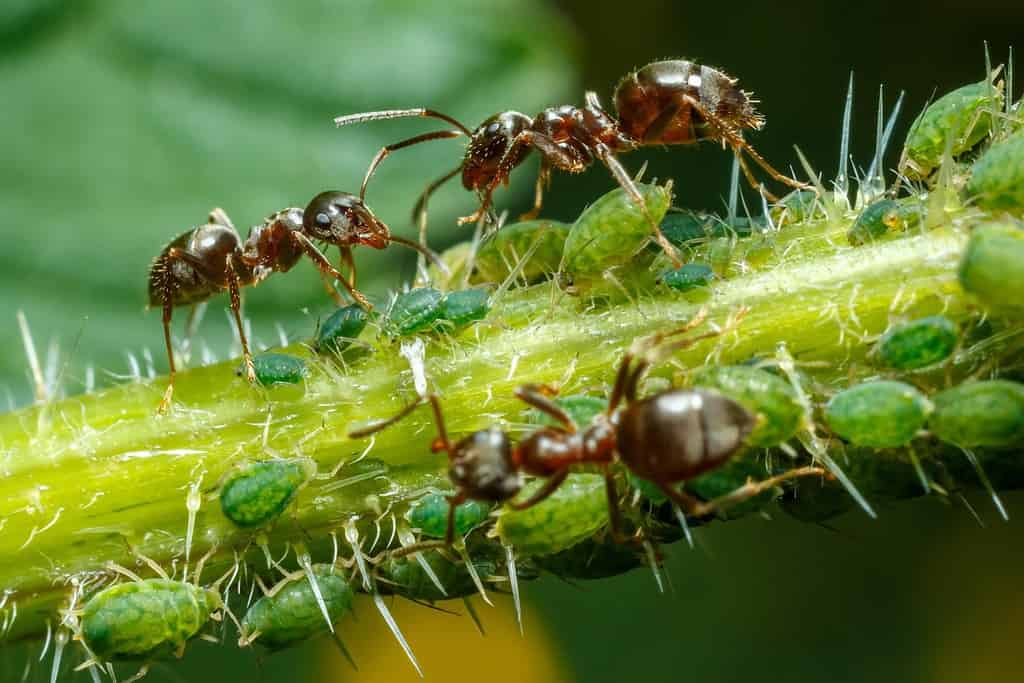
The post A Closer Look at How Ant Colonies Raise the Next Generation appeared first on A-Z Animals.
The unusual life cycles of ants are deeply rooted in their social nature. Ants and other social insects like termites, some bees, and certain wasps live in colonies, in which most individuals never have offspring. Instead, they work in service of the colony, supporting an extremely reproductive queen who acts as a nonstop laying machine. Said Smithsonian entomologist Ted Schultz in an interview, “In some ant species, workers are divided into physical castes such as ‘major’ workers (sometimes called ‘soldiers’) and ‘minor’ workers, each of which do very different jobs.” This reproductive inequality, combined with cooperative work across generations, places ant colonies at the extreme of true sociality (or, eusociality).
Ants in the Beginning

The white spherical things are pupae in this rover ant colony (genus
Brachymyrmex)
©Vinicius R. Souza/Shutterstock.com
Every ant begins life as a tiny, oval egg that is tended by its nestmates in the colony until it hatches. As a blind larva with no legs, a larva relies on colony adults to continuously feed it. When it’s big enough, it enters a pupal stage (as do butterflies), during which it undergoes a metamorphosis, transforming into its adult shape over a period of several weeks or months, depending on the ant species.
At first, the new adult or “callow worker” has a pale, soft exoskeleton, which darkens and firms over time. Each ant is either a male, a female worker, or a female queen. Explains evolutionary biologist Daniel Kronauer, “The brains of a queen and a worker are quite different, and this is correlated with striking differences in behavior. Workers leave the nest to forage, take care of the larvae, build and expand the nest; the queen mostly just mates and lays eggs.”
Let’s look at the life cycles of each category of ant and see how these differences emerge.
Male Ant Life Cycle

This male thief ant (Genus
Carebara) has wings for his nuptial mating flight.
©Vinicius R. Souza/Shutterstock.com
In some ant species, workers are divided into physical castes such as ‘major’ workers (sometimes called ‘soldiers’) and ‘minor’ workers, each of which do very different jobs.
Ted Schultz, Smithsonian entomologist
Unfertilized eggs become male ants. The life cycle of a male ant is short! After it emerges as an adult, its only job is to mate. Young ants preparing to reproduce (alates) wait for hot and humid conditions to fly out of the colony in search of mates. It’s easy to mistake alate ants for flies or some other flying insect, because during their “nuptial” mating flights, they temporarily sport wings. Hundreds of them may pour out of a colony entrance and accumulate on the forest floor.
Once a male ant finds a partner and mates in the air, its wings drop off, leaving it confined to the ground once more. After just a few days, the males die. Their jobs are done; they have mated with a future queen and shared their genes. But females who stay behind and do not make a nuptial flight are the colony’s workers. These ants have jobs to do, which can last several months.
Female Ant Life Cycle

This yellow meadow ant worker has sturdy mandibles (mouthparts) for doing her colony work.
©Holger Kirk/Shutterstock.com
Fertilized eggs become female ants. After metamorphosis, a non-queen female ant assumes one of the available colony jobs, which fall into the categories of transporting food, maintaining the nest, defending against intruders, or taking care of the young. As a colony grows from just a few individuals to hundreds or thousands, worker ants may further specialize as soldiers, nurses who feed the babies, or excavators who dig tunnels and repair damage.
You can often match a worker’s body shape with their job; for example, soldiers are typically larger with big, strong mandibles. Smaller workers might be day care staff (tending eggs and larvae) and foragers. In some ant species, said Schultz, “all the workers look the same, and in some of those so-called ‘monomorphic’ species, workers divide up the work based on their ages, a system known as ‘age-based polyethism’.” In those species, the young workers might work in brood care, while the older ones venture out of the nest to collect food.
Although a female worker comes from a fertilized egg, thus with a complete set of genes, she does not typically have the capacity to reproduce. Some workers, depending on species and distance from the queen in the colony, may lay unfertilized “trophic” eggs that are used to feed the brood. A study published in Current Opinion in Insect Science found that females who become workers have limited ovary development and that the presence of the queen inhibits further development. The queen produces pheromones that inhibit reproduction, which are picked up by chemical receptors on worker antennae. Thus, in some species, the death of a queen will allow workers to become reproductive.
Queen Ant Life Cycle

This queen carpenter ant (
Camponotus sp.) is much bigger than her workers and pupae.
©Poravute Siriphiroon/Shutterstock.com
Without a queen, the colony would not exist. Queen ants get a boost from the colony from the time they hatch. Although it’s not entirely clear how certain ants are designated “royalty,” larvae of future queens are fed more, grow larger, and develop functional ovaries and spermatheca for laying fertilized eggs (unlike workers, who at most lay unfertilized eggs). A study published in PNAS found that genetic differences between individuals contribute to their chances of becoming queens.
Those ants born into queenhood have an entirely different trajectory in life. After her nuptial flight, during which she may mate with several males, the queen—rather than returning to the colony—starts her own nest. She finds a secluded site, seals herself in, and lays the first batch of eggs, which yield “nanitics,” worker ants who will take care of the colony. The queen initially feeds her brood with unfertilized eggs but eventually passes the responsibility of feeding the nanitics to older female offspring.
As the queen continues laying, the colony grows tremendously during what’s called the “ergonomic stage,” when all the colony’s energy goes to producing more workers. A study published in PLoS One found that in the ant species Cardiocondyla obscurior, a queen’s fecundity (egg production) increased with age right up until death. As the colony grows, workers’ roles increasingly specialize as part of the organized division of labor maintained by the queen’s leadership in the form of pheromones (chemical signals).
Only once it reaches a certain sustainable size does a colony start producing male offspring and new queens. During this “reproductive stage,” the colony shifts its focus from growth to producing more alates, which may go on to establish new colonies. Queens live much longer than their minions, in some species for nearly 30 years.
The Demise of the Queen

When a queen dies, a colony of ants, such as these leafcutters, may lose its crucial division of labor.
©Matyas Rehak/Shutterstock.com
Eventually, a queen ant dies, which for most species ends the colony. The remaining ants, without their leader, tend to drift away from their tasks and die. However, in certain species that have multiple queens in a nest, the death of one is not catastrophic for the colony.
A study published in Genes & Development found that, in Indian jumping ants, the death of their queen results in a dominance contest for a new queen. These ants duel by whapping each other with their antennae, with the winner becoming a replacement queen. “Despite the fact that dueling tournaments last for several weeks, we were able to anticipate which ants would become pseudoqueens in only three days,” said Comzit Opachaloemphan, a doctoral student and author of the study.
The research showed that, for this species, the death of the queen and the resulting loss of her chemical pheromone signals triggered genetic changes in some workers. As genes that regulate developing ovaries were switched on, those workers became “pseudoqueens” who competed for reproductive leadership of the colony.
Lessons for Humans?

Through cooperation, ants do remarkable tasks, such as tending aphids to benefit from their sweet, honeydew secretions.
©Szasz-Fabian Jozsef/Shutterstock.com
A study published in Nature explored the origins and implications of the eusociality of ant colonies. Study author and evolutionary biologist Christophe Tokita noted in a press release that social insect groups are more successful than solitary insects (that don’t live in colonies) because “there are ‘more hands to do work,’ so to speak. Important tasks don’t slip through the cracks, because chances are there’s always an individual to do the task.”
Said entomologist Ted Schultz, “Caste-based division of labor reflects the inherent eusociality of ant colonies, in which the colony as a whole is analogous to an organism and the individual ants are analogous to the cells and tissues of that colony-level organism.”
The post A Closer Look at How Ant Colonies Raise the Next Generation appeared first on A-Z Animals.
November 22, 2025 at 07:32PMDevin Reese
.jpeg)
.jpeg)

0 Comments